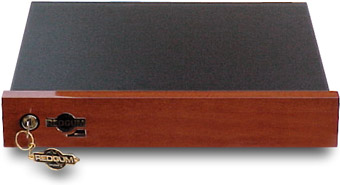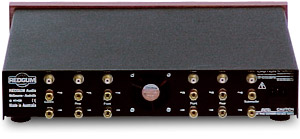
|

Redgum Audio
RGH900 Six-Channel Amplifier

|
|
|
 |

DescriptionPrice: $2800 USD
Dimensions: 16.5"W x 14.2"D x 3.35"H
Weight: 24 pounds
Warranty: Seven years parts and labor |

Features
- Six channels rated at 150Wpc
- High-quality binding posts
- Single-ended RCA inputs
- Removable IEC power cord
- Cooling fan
- Unique and attractive cosmetics featuring solid Redgum wood
front panel
- Keyed power switch
- Compact design
|
If you have not heard of Redgum electronics,
you are probably not alone. Designed and manufactured in Australia, they are relatively
unknown in the North American market. However, Redgum markets a full line of
preamplifiers, power amplifiers, integrated amplifiers, CD players and DACs, even
speakers. They are not inexpensive, but they are reasonably priced and seem to offer good
value. Doug Schneider reviewed the Redgum RGi120 integrated amp for SoundStage!
and saw fit to give it a Reviewers’ Choice recommendation. Not only that, but it was
later given the coveted SoundStage! Best Product Debut Award at the 2001 CES. Doug
found it to be "exceedingly clean, wholly natural, and completely listenable" --
high praise indeed.
Like many other hardware manufacturers, Redgum offers a
multichannel amplifier designed for home-theater use, which is the subject of this review.
The RGH900 appears to be similar in design to the RGi120, but could Redgum construct a
multichannel amplifier that sounds as good as their two-channel integrated?
Description
All of the Redgum components share the same basic
appearance that features a distinctive front panel constructed of varnished redgum wood,
presumably the genesis of the name. But the on/off switch of these products is their most
unique design feature: a key that comes with a Redgum-logo key chain. Thankfully the key
can be removed whether in the on or off position so that it does not always have to be
inserted in the amp. However, if you lose the key, you will have to contact Redgum to
receive a replacement, which can be reproduced from the serial number of your unit.  Depending on your point of view, you may
think of these design features as gimmicky, but I found the nicely finished front panel to
be quite attractive -- although I was less enthusiastic about the key. Depending on your point of view, you may
think of these design features as gimmicky, but I found the nicely finished front panel to
be quite attractive -- although I was less enthusiastic about the key.
The RGH900 is very small for a multichannel amplifier and
is actually smaller than many two-channel amplifiers that I have encountered. However, it
is suitably hefty and features a cooling fan and heavy-duty gold-plated five-way binding
posts. I found the back panel of the amp to have a little give to it, which was a
little disconcerting when connecting or removing very tight-fitting RCA connectors.
Otherwise, the RGH900 looked and operated like a high-quality amplifier.
The sound
I will admit that after reading Doug Schneider’s very
positive review of the Redgum integrated amp, my expectations were raised for this
multichannel amplifier, but I was still not expecting the extremely high level of
performance that I received from the RGH900. Although I have not heard the Redgum
integrated that Doug found so enticing, I suspect that the sound of the two amps is very
similar based on his observations and what I experienced with the RGH900. The multichannel
Redgum was also able to exhibit a very neutral character that was powerful and yet
retained a refined sound when called upon. One day I even invited a friend over to listen
to the Redgum and used it at one point to play back some CDs in two-channel mode. It
sounded so good that he thought it was an expensive stereo amplifier and was
surprised to discover that inside the compact chassis there were actually six channels of
very high-quality amplification.
Two channels
The Redgum RGH900 spent a fair amount of time in a
two-channel setup with my Krell integrated acting as a preamplifier. In this
configuration, it proved to be an excellent performer. Because the Redgum’s sound was
so neutral, it is a little difficult to describe. There were no glaring deficiencies to
the sound, nor were there any areas in which it seemed to excel more than others. The
sound was balanced from top to bottom and differed very little from the sound of my
reference Krell when it is used as an integrated amplifier.
Although the sound was neutral, it was in no way anemic or
uninvolving. To the contrary, the sound was big, bold and well defined from left to right
and front to back. Both Eva Cassidy and Ani Difranco were suitably "there" in
the presentation of their vocals, with a great amount of inflection in their voices that
provided the nuances required to make vocals palpable. Not only were their vocals solid
and powerful with plenty of air around them, they did not distort or become compressed
when the amp was pushed hard. Rachmaninoff’s Piano Concerto No. 3 with Arcadi
Volodos and the Berlin Philharmonic [Sony SK 64384], which I acquired based on Srajan
Ebaen’s review, was reproduced beautifully, with a broad, deep soundstage. The timbre
of the piano was bang-on, with the imaging of the instrument not being overly precise but
naturally near the center of the soundstage and offering good layering and placement of
the rest of the orchestra.
Multichannel
The Redgum amp was just as accomplished with movie
soundtracks as it was with two-channel music. Rated at 150Wpc, the RGH900 demonstrated the
same sophisticated sound that it displayed on music: a stunning combination of power and
authority. With excellent dynamics and the ability to play very loud without coloring the
sound, this amplifier brought movie soundtracks to life with amazing realism. For
instance, while most amps can reproduce the diffuse, flowing vocals and sweet strings of
Chapter 27: "Home Again" from Gladiator, the Redgum also gave Connie
Nielsen’s voice a lifelike quality that was startling. Her voice in this scene is
very revealing of center-channel speakers and amplification as it is recorded at a very
high level that will cause lesser components to have fits trying to reproduce it.
Funky techno soundtracks also sounded terrific, such as in
"Fake War Casualties" from Romeo Must Die. The driving bass line was
taught and punchy, and synthesized instruments imaged precisely and solidly across the
front soundstage. Foley effects, such as the gunfire, changed timbre along with the camera
angle and the sounds of ejected shell casings and the gun actions were remarkably well
delineated amongst the general din of the scene.
Comparison
There really was no comparison between the Redgum and my
budget reference multichannel amplifier, the Anthem MCA5, which was easily bettered in
nearly every aspect by the RGH900. The Anthem amp could play louder and had more punch
down low, but the Redgum was definitely the more accomplished amplifier. Even though the
Anthem could reveal a lot of detail and imaged well, the images were more "cut
out," with less air around them, and the soundstage lacked the depth and lateral
space that the Redgum amp exhibited. The Redgum costs twice as much as the Anthem ($1399),
putting it a little on the expensive side of things, but in this case you really do get
what you pay for, and the added cost is money well spent.
When pitted against my reference two-channel Krell
integrated amp ($2500), the Redgum did not suffer much in comparison, even with the added
set of interconnects required to utilize it. Going back and forth between the Redgum and
the Krell, I kept searching for something that would prove that the Krell was demonstrably
better, but I could not find anything. Yes, the Krell still had better control in the bass
regions and could extract more detail from recordings, but the Redgum had a slightly more
holistic sound that was smoother and more refined overall. There were certainly
differences in the sound of the two amps, but they were minor, and the Redgum amp was just
as pleasing to listen to over the long haul as the Krell.
Conclusion
The Redgum RGH900 is an impressive amplifier. It combines
exceptional sound quality, relatively high power output, and unique and attractive
cosmetics all in a compact package. It is not cheap at $2800, but the added performance
over less expensive amplifiers is more than commensurate with the increase in price. Its
six channels of amplification make it ideal for 6.1 surround formats such as Dolby Digital
EX and DTS-ES. More importantly, it makes both music and movie soundtracks really come
alive. It is able to sort out complex passages in films, with voices presented with a
realism that I had not previously heard in my system, while still reproducing dynamic
sound effects and music simultaneously. The RGH900 sounded like a more expensive amplifier
than it is and actually sounded less like a "multichannel home-theater
amplifier" and more like what many would expect from a high-quality stereo amp. In
fact, it was so good that I lived with it for many weeks as the main source of
amplification for my combined home-theater and music system -- happily.
| Review
System |
| Speakers - Infinity
Compositions Prelude (mains), Boston Acoustics 555x (center), Definitive Technology BP-10
(surrounds), Paradigm PW-2200 subwoofer |
| Amplifiers
- Anthem MCA5, Krell KAV-300i |
| Processor - Sherwood
Newcastle AVP-9080R, Arcam AVR100 |
| Sources
- Pioneer DV-626D DVD player, Teac VRDS-T1 transport, MSB Link DAC III with 24/96
Upsampling, Half Nelson, and P1000 power supply upgrades, Monarchy 24/96 DIP |
| Cables - Nordost, Sonic
Horizon, Straightwire, Audio Quest, Monster, ESP power cords and power distributor |
| Monitor
- Toshiba CX32H60 direct-view |
|
|

